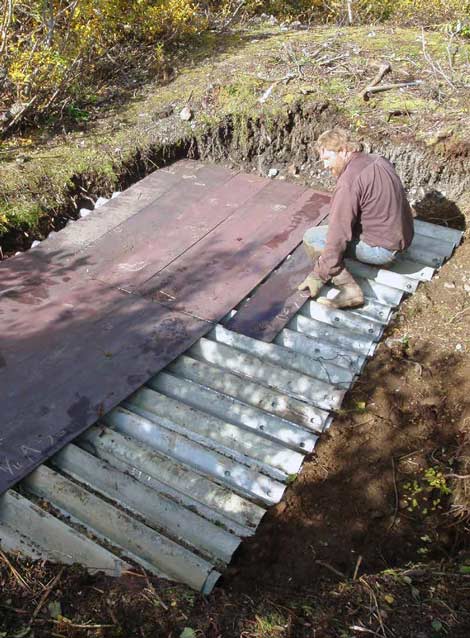
C. Justin Ireys
The federal Surface Mining Control and Reclamation Act was signed into law on August 3, 1977, to regulate surface coal mining and reclamation nationwide. In May of 1983 the State of Alaska took primacy of the Abandoned Mine Lands (AML) program and for the past 31 years has been working in all corners of the state to reclaim abandoned mines.
Land and water that are eligible for the reclamation are those that were mined or affected by mining and abandoned or left in an inadequate reclamation status prior to the law passing in 1977. AML funds can be spent on coal and non-coal abandoned historic mines. State, private, Alaska Native, and federal lands are eligible.
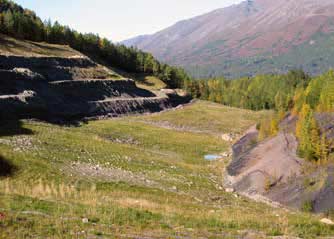
C. Justin Ireys
The fee collection that provides the funds that the federal government distributes to the various states and tribal entities has been extended by Congress until September 30, 2022. The AML Program is funded 100 percent by the AML Trust Fund, which is administered by the federal Office of Surface Mining Reclamation and Enforcement; there are no state general fund dollars used in the AML Program. AML funds are collected from a fee assessed on today’s coal industry for every ton of coal produced and used to correct past deficiencies on now-defunct mine sites. The fee is 28 cents per ton for surface mines and 12 cents per ton for underground mines.
Alaska is considered a Minimum Program state and has been funded at the Minimum Program level since 1994. The grant amount for Minimum Program states is currently set at $3 million annually. These funding levels will remain constant until 2022, although it is important to note that AML’s annual grants are subject to federal sequestration.
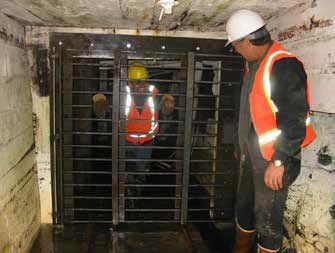
C. Justin Ireys
Inventory and Accomplishments
Alaska’s coal and non-coal abandoned historic mines were broadly inventoried in 1983, and 340 sites were identified. Coal mining in Alaska has been well documented and every mine of significance has been identified.
Every inventoried site was evaluated to determine if it qualified for AML funding. Federal policy requires that priority one and two coal projects (the most likely to cause death or severe injury to site visitors) be completed first.
Priority three coal projects (environmental issues) can be completed in conjunction with priority one and two projects or after all priority one and two projects have been completed. Because the funds are generated from active coal mines, only priority one non-coal projects can be reclaimed.
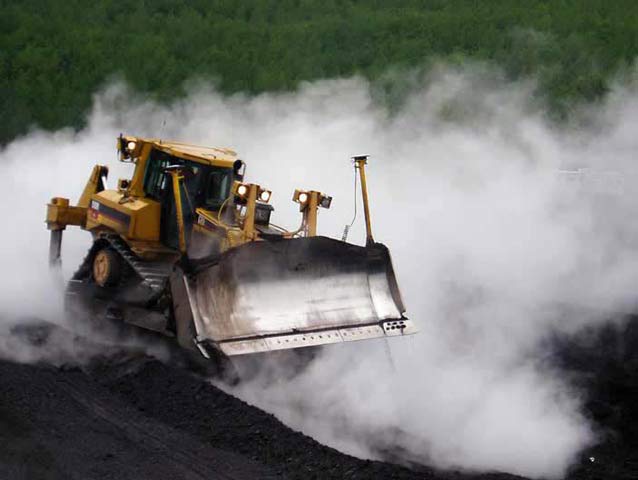
C. Justin Ireys
The three reclamation priorities are:
- Protection of public health, safety, general welfare, and property from extreme danger resulting from the adverse effects of past coal mining practices.
- Protection of public health, safety, and general welfare from adverse effects of past coal mining practices, which do not constitute an extreme danger.
- Restoration of eligible lands and waters and the environment previously degraded by adverse effects of past coal mining practices, including measures for the conservation and development for soil, water (excluding channelization), woodland, fish and wildlife, recreation resources, and agricultural productivity.
Using these general priorities, it was determined that there are 15 very large coal project areas and eight known non-coal projects that still need to be reclaimed.
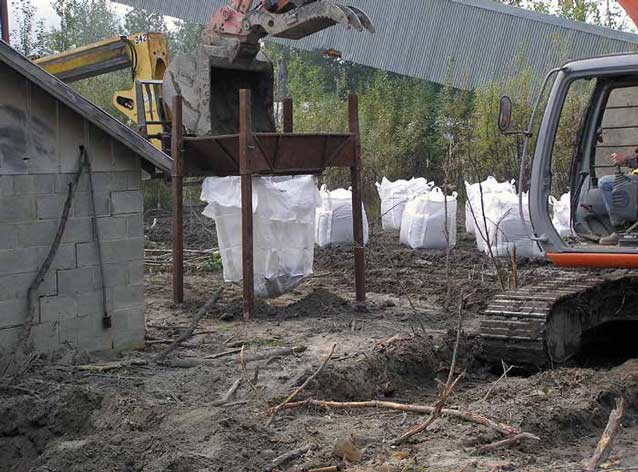
C. Justin Ireys
To date, 88 AML projects have been completed at a cost of $23.77 million. The majority of the remaining coal related hazards are dangerous highwalls (19,750 feet/6,020 meters) and surface burning (10 acres/4 hectares). The majority of non-coal hazards are open portals (10) and vertical openings (19).
AML Past Projects
The program has accomplished remediation and mine closures in nearly every region of Alaska. Dangerous highwalls have been re-sloped; coal refuse fires have been extinguished; hazardous materials such as PCBs, hydrocarbons, and asbestos have been removed; dangerous buildings and facilities have been demolished; and numerous mine openings have been sealed.
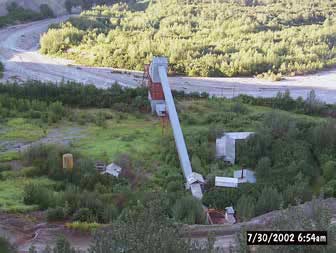
Carol Woody
Highwall Projects
The AML Program has reclaimed nearly 12,000 feet (3,658 meters) of dangerous highwalls. These projects were all in the Sutton area near the old Jonesville Mine (Figure 2).
Dangerous Mine Openings
Since 1983 the program has closed 67 shafts and 45 portals. Depending on site conditions and location a variety of different closure methods can be used. Steel gate structures, polyurethane foam, backfilling, and concrete caps have all been used (Figures 1 and 3).
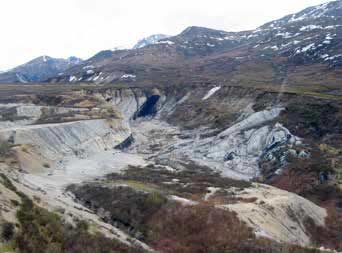
C. Justin Ireys
Coal Refuse Fires
Years of coal mining in the Sutton area left acres and acres of coal spoils that eventually caught fire from spontaneous combustion and camp fires. The AML program has spent $8.5 million to extinguish or suppress 67 acres (27 hectares) of coal refuse fires (Figure 4).
Hazardous Materials
Hazardous materials leftover from abandoned mines can be dangerous to both people and the environment. Asbestos, PCBs, and hydrocarbons are often found at abandoned mine sites (Figure 5).
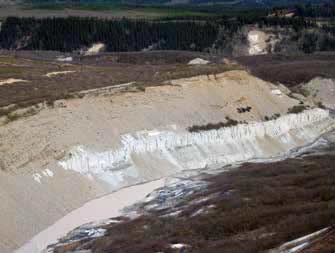
C. Justin Ireys
Hazardous Equipment and Facilities
Prior to improved and more stringent mining laws, mining companies simply walked away when ore reserves were depleted or uneconomical. These old mining buildings can be fascinating but they are also an attractive nuisance. As the buildings age, they become dilapidated and dangerously unstable. At the Suntrana Tipple site, the AML program spent nearly $1 million demolishing buildings and cleaning contaminated soil (Figure 6).
AML Future Projects: Healy Creek Strip Pits
From the 1920s through the 1960s large scale surface coal mining occurred in Healy Valley, Alaska, along the south side of Healy Creek. After the economical coal was mined out, the strip pits were abandoned without being reclaimed. This left behind well over 300 acres (121 hectares) of disturbed lands in seven individual pits, comprising a series of dangerous highwalls, steep footwalls, and out-of-pit spoil piles. The AML Program will be reclaiming this area for the next nine years.
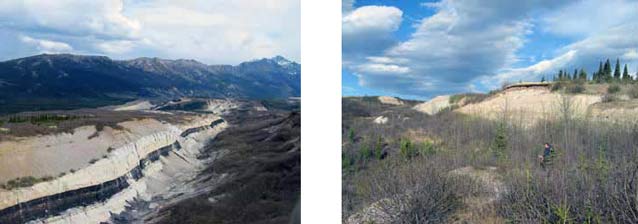
C. Justin Ireys
Hydraulic Pit (Reclamation 2014-2015)
The Hydraulic Pit has dangerous highwalls and severe erosion issues from wind and water. The south and east walls are more than 300 feet (91 meters) high. A 600-foot (182-meter) -long portion of the north wall is nearly vertical and over 200 feet (61 meters) high. A significant amount of water flows through the pit, creating large amounts of erosion and re-deposition of sediments (Figure 7).
Vitro Pit (Projected Reclamation 2016)
Vitro Pit is approximately 2,500 feet (762 meters) long, bordered by a highwall 120-140 feet (36-42 meters) high along most of its northern length. There are also minor erosion issues from water discharge out of the northeast corner of the pit (Figure 8).
East Cripple Creek Pit (Projected Reclamation 2017-2019)
East Cripple Creek Pit is approximately 2/3 of a mile (1 kilometer) long and contains significant highwalls. Surface water flow is creating substantial erosion. A continuous, dangerous highwall borders the entire northern length of the pit, most of it at least 100 feet (30 meters) tall (Figure 9).
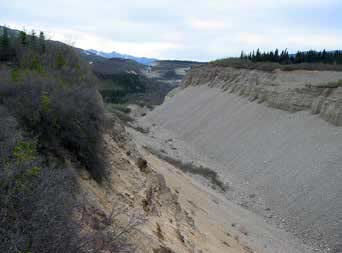
C. Justin Ireys
West Coal Creek Pit (Projected Reclamation 2020)
West Coal Creek Pit has roughly 1,500 lineal feet (457 meters) of continuous highwall that is 30-40 feet (9-12 meters) high and is surrounded by established vegetation (Figure 10).
East Coal Creek Pit (Projected Reclamation 2021)
East Coal Creek Pit is stable and dry, with little evidence of active erosion other than mass wasting. Highwalls and footwalls composed of poorly cemented sandstone and loose gravel are exposed in the upper 20 feet (6 meters) of the pit walls; however, vegetation surrounding the pit rim is thick and dense (Figure 11).
Center Pit (Projected Reclamation 2022)
The Center Pit has sides approximately 100 feet (30 meters) high and turquoise blue water of unknown depth and quality impounding the entire length of its floor. The west end of the pit is steeper than 1:1 (Figure 12).
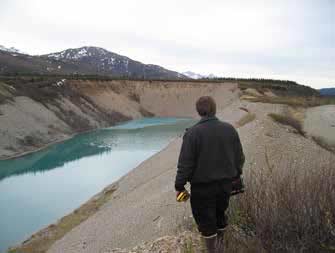
C. Justin Ireys
Apex Pit (Projected Reclamation 2023)
The Apex Pit is the furthest east of the Healy Creek Strip Pits. On the far eastern end of the pit is a section of highwall measuring approximately 100 feet (30 meters) long and rising 40 vertical feet (12 meters) (Figure 13).
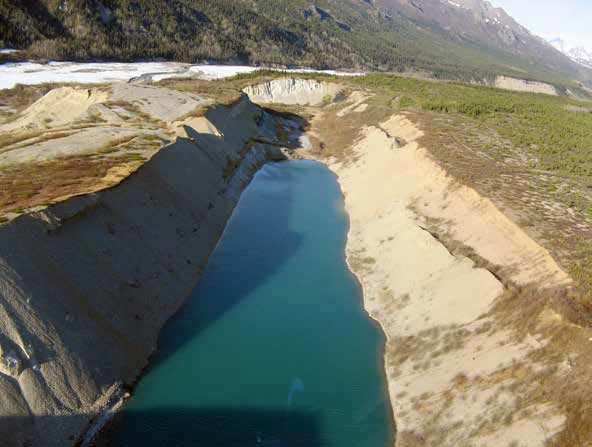
C. Justin Ireys
The Apex Pit will be reclaimed in 2023.
Part of a series of articles titled Alaska Park Science - Volume 13 Issue 2: Mineral and Energy Development.
Last updated: June 16, 2015
